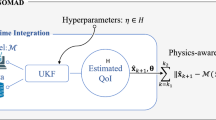Abstract
Current methods for uncertainty propagation suffer from their limitations in providing accurate and efficient solutions to high-dimension problems with interactions of random variables. The sparse grid technique, originally invented for numerical integration and interpolation, is extended to uncertainty propagation in this work to overcome the difficulty. The concept of Sparse Grid Numerical Integration (SGNI) is extended for estimating the first two moments of performance in robust design, while the Sparse Grid Interpolation (SGI) is employed to determine failure probability by interpolating the limit-state function at the Most Probable Point (MPP) in reliability analysis. The proposed methods are demonstrated by high-dimension mathematical examples with notable variate interactions and one multidisciplinary rocket design problem. Results show that the use of sparse grid methods works better than popular counterparts. Furthermore, the automatic sampling, special interpolation process, and dimension-adaptivity feature make SGI more flexible and efficient than using the uniform sample based metamodeling techniques.
Similar content being viewed by others
References
Barthelmann V, Novak E, Ritter K (2000) High dimensional polynomial interpolation on sparse grids. Adv Comput Math 12:273–288
Du X, Chen W (2000) Towards a better understanding of modeling feasibility robustness in engineering design. J Mech Des 122:385–394
Du X, Chen W (2001) A most probable point-based method for efficient uncertainty analysis. J Design Manuf Autom 4:47–66
Du X, Chen W (2004) Sequential optimization and reliability assessment method for efficient probabilistic design. ASME J Mech Des 126(2):225–233
Du X, Sudjianto A, Chen W (2004) An integrated framework for optimization under uncertainty using inverse reliability strategy. J Mech Des 126:562–570
Gerstner T, Griebel M (1998) Numerical integration using sparse grids. Number Algorithms 18:209–232
Gerstner T, Griebel M (2003) Dimension-adaptive tensor-product quadrature. Computing 71:65–87
Irfan K (2005) Application of Kriging method to structural reliability problems. Struct Saf 27:133–151
Jin R, Chen W (2005) An efficient algorithm for constructing optimal design of computer experiment. J Stat Plan Inference 134:268–287
Klimke A (2006a) Sparse grid interpolation toolbox—user’s guide. IANS report 2006/001, University of Stuttgart
Klimke A (2006b) Uncertainty modeling using fuzzy arithmetic and sparse grids. PhD dissertation, Institut für Angewandte Analysis und Numerische Simulation Universität Stuttgart
Klimke A, Wohlmuth B (2005a) Piecewise multilinear hierarchical sparse grid interpolation in MATLAB. ACM Trans Math Softw 31:561–579
Klimke A, Wohlmuth B (2005b) Computing expensive multivariate functions of fuzzy numbers using sparse grids. Fuzzy Sets Syst 154:432–453
Lee SH, Chen W (2008) A comparative study of uncertainty propagation methods for black-box type functions. Struct Multidiscipl Optim 37:239–253
Lee I, Choi KK, Du L (2006) Alternative methods for reliability-based robust design optimization including dimension reduction method. In: 32nd ASME design automation conference, Philadelphia, PA, 10–13 September 2006
Lee I, Choi KK, Du L, Gorsich D (2008a) Dimension reduction method for reliability-based robust design optimization. Comput Struct 86:1550–1562
Lee I, Choi KK, Du L, Gorsich D (2008b) Inverse analysis method using MPP-based dimension reduction for reliability-based design optimization of nonlinear and multi-dimensional systems. Comput Methods Appl Math 198:14–27
Nie J, Ellingwood BR (2000) Directional methods for structural reliability analysis. Struct Saf 22:233–249
Novak E, Ritter K (1996) High dimensional integration of smooth functions over cubes. J Numer Math 75:79–97
Novak E, Ritter K (1999) Simple cubature formulas with high polynomial exactness. Constr Approx 15:499–522
Rackwitz R (2001) Reliability analysis—a review and some perspectives. Struct Saf 23:365–395
Rahman S, Wei D (2006) A univariate approximation at most probable point for higher-order reliability analysis. Int J Solids Struct 43:2820–2839
Rahman S, Xu H (2004) A univariate dimension–reduction method for multidimensional integration in stochastic mechanics. Probab Eng Mech 19:393–408
Rosenblatt M (1952) Remarks on a multivariate transformation. Ann Math Stat 23:470–472
Seo HS, Kwak BM (2002) Efficient statistical tolerance analysis for general distributions using three-point information. Int J Prod Res 40:931–944
Smolyak SA (1963) Quadrature and interpolation formulas for tensor products of certain classes of functions. Sov Math, Dokl 4:240–243
Tao J, Zeng X, Cai W, Su Y, Zhou D, Chiang C (2007) Stochastic sparse-grid collocation algorithm (SSCA) for periodic steady-state analysis of nonlinear system with process variations. In: Proc ASPDAC 5A-5, Jan 2007, pp 474–479
Wang G, Wang L, Shan Q (2005) Reliability assessment using discriminative sampling and metamodeling. SAE Transact 114:291–300
Wu Y (1994) Computational methods for efficient structural reliability and reliability sensitivity analysis. AIAA J 32:1717–1723
Xiu D, Hesthaven J (2005) High order collocation method for differential equations with random inputs. SIAM J Sci Comput 27:1118–1139
Xu H, Rahman S (2004) A generalized dimension–reduction method for multidimensional integration in stochastic mechanics. Int J Numer Methods Eng 61:1992–2019
Xu H, Rahman S (2005) Decomposition methods for structural reliability analysis. Probab Eng Mech 20:239–250
Youn B, Xi Z, Wells L, Wang P (2006) Enhanced dimension reduction (eDR) method for sensitivity-free uncertainty quantification. In: 11th AIAA/ISSMO multidisciplinary analysis and optimization conference, Portsmouth, Virginia, 6–8 September 2006
Youn B, Xi Z, Wang P (2008) Eigenvector dimension reduction (EDR) method for sensitivity-free probability analysis. Struct Multidiscipl Optim 37:13–28
Zhao L, Yang S (2008) Application of MDO to conceptual design of WAF rockets. 7th ASMO-UK/ISSMO International Conference on Engineering Design Optimization, Bath, UK, 7–8 July, 2008
Author information
Authors and Affiliations
Corresponding author
Rights and permissions
About this article
Cite this article
Xiong, F., Greene, S., Chen, W. et al. A new sparse grid based method for uncertainty propagation. Struct Multidisc Optim 41, 335–349 (2010). https://doi.org/10.1007/s00158-009-0441-x
Received:
Revised:
Accepted:
Published:
Issue Date:
DOI: https://doi.org/10.1007/s00158-009-0441-x




